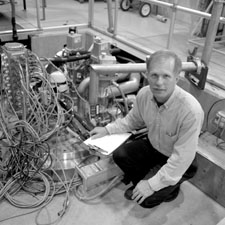 |

Tom Peterson’s Dewar Debut by Sharon Butler Tom Peterson started out as an amateur lepidoterist and ended up a professional engineer and an internationally recognized expert in the science of the very cold. But he still watches butterflies. In fact, any lunchtime you may see him biking over to the Margaret Pearson Nature Trail, in the new prairie, and hanging about the summer flowers, where he recently spied a Pipevine Swallowtail. It is a lovely butterfly with iridescent blue wings, one he’s never seen before in these parts. But more often than not, Peterson is holed up in a trailer office behind the Industrial Building Complex, his bicycle parked in front while he labors over designs for cryogenic hardware inside. His work on a vertical magnet test facility just brought him an employee recognition award. The test facility is a vertical vat holding a helium bath, into which magnets are lowered, one at a time, for performance testing. It will be used—indeed, has already been used—to test prototype superconducting magnets for the Large Hadron Collider, now under construction at CERN. The multiton magnets are each two meters long, miniature versions of the final magnets, which will be six meters in length. Peterson’s contribution to the test facility was the dewar, the double walled container with a vacuum in between, like a giant thermos bottle. The dewar is the part of the test facility that keeps the magnet very cold during the one-month-long round of tests. But Peterson’s dewar is not just any dewar. "It’s a special dewar that allows us to test magnets in superfluid helium," Peterson explained. The LHC will run at roughly atmospheric pressure at a temperature of only 1.9 degrees Kelvin, even lower than the Tevatron’s 4.4 K. The colder temperature will allow more current in the magnets and, so, more energy in the accelerator. But below 2.17 K, liquid helium becomes a superfluid with properties all its own. It loses viscosity and becomes an extremely efficient conductor of heat, Peterson said. Challenge enough was designing an absolutely leakproof dewar. But the dewar also had to include a cooling system. Consequently, Peterson’s dewar is especially complex, with three valves, two heat exchangers, a load of piping, and an array of temperature and pressure sensors. In a series of cooling stages, liquid helium at 4.5 K from the liquefier in Industrial Building 1 is pumped down to a lower pressure and a lower temperature, and that low-pressure, low-temperature helium flows through two heat exchangers to cool the higher-pressure helium that surrounds the magnet in the test facility. "The process of doing this cooling and maintaining the low 1.9 K temperature is a little tricky," Peterson said. The whole project, from first discussions and designs to fabrication, took about two years. Assembling the rest of the test facility around the dewar, with attendant instrumentation, power supplies, and software, took another six months. Only then could the design be tested. Remembering the December 1996 debut of the dewar, Peterson laughs, "I think the fact that it worked right off so relieved Peter Limon [head of the Technical Division] that he recommended me for this award." |
| last modified 6/18/1999 email Fermilab |
FRLsDFx9eyfrPXgV